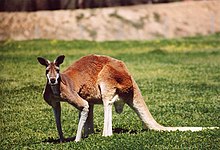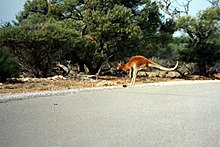Red kangaroo: Difference between revisions
may have slightly less quailty but makes less difference when it's this size |
|||
| Line 4: | Line 4: | ||
| status_system = iucn3.1 |
| status_system = iucn3.1 |
||
| status_ref = <ref name=iucn>{{IUCN2008|assessors=Ellis, M., van Weenen, J., Copley, P., Dickman, C., Mawson, P. & Woinarski, J.|year=2008|id=40567|title=Macropus rufus|downloaded=28 December 2008}} Database entry includes justification for why this species is of least concern </ref> |
| status_ref = <ref name=iucn>{{IUCN2008|assessors=Ellis, M., van Weenen, J., Copley, P., Dickman, C., Mawson, P. & Woinarski, J.|year=2008|id=40567|title=Macropus rufus|downloaded=28 December 2008}} Database entry includes justification for why this species is of least concern </ref> |
||
| image = Red |
| image = Red Kangaroo 001.jpg |
||
| regnum = [[Animal]]ia |
| regnum = [[Animal]]ia |
||
| phylum = [[Chordate|Chordata]] |
| phylum = [[Chordate|Chordata]] |
||
Revision as of 04:34, 4 January 2010
| Red Kangaroo[1] | |
|---|---|

| |
| Scientific classification | |
| Kingdom: | |
| Phylum: | |
| Class: | |
| Infraclass: | |
| Order: | |
| Family: | |
| Genus: | |
| Species: | M. rufus
|
| Binomial name | |
| Macropus rufus Desmarest, 1822
| |
The Red Kangaroo (Macropus rufus) is the largest of all kangaroos, the largest mammal native to Australia, and the largest surviving marsupial. It is found across mainland Australia, avoiding only the more fertile areas in the south, the east coast, and the northern rainforests.
Description

This species is a very large kangaroo with short, red-brown fur, fading to pale buff below and on the limbs. It has long, pointed earlobes and a squared-off muzzle. Females are smaller than males and are blue-grey with a brown tinge, pale grey below, although arid zone females are coloured more like males. It has two forelimbs with small claws, two muscular hind-limbs, which are used for jumping, and a strong tail which is often used to create a tripod when standing upright.
The Red Kangaroo's legs work much like a rubber band. The males can leap over 9 metres (30 ft) in one leap.[3]
Males grow up to a body length of 1.4 metres (4 ft 7 in) long and weigh up to 85 kilograms (187 lb). Females reach a body length of up to 1.1 metres (3 ft 7 in) long and weigh up to 35 kilograms (77 lb). Tails can be from 0.9 to 1 metre (3.0–3.3 ft) long. The average Red Kangaroo stands approximately 1.5 metres (4 ft 11 in) tall.[4] Accounts of sizes greater than this are not uncommon, with some large males reportedly reaching approximately 2 metres (6 ft 7 in).
The Red Kangaroo maintains its internal temperature at a point of homeostasis about 36 °C (97 °F) using a variety of physical, physiological and behavioural adaptations. These include having an insulating layer of fur, being less active and staying in the shade when temperatures are high, panting, sweating, and licking its forelimbs.
The Red Kangaroo's range of vision is approximately 300° due to the position of its eyes.[citation needed]
Ecology
The Red Kangaroo ranges throughout central Australia. Its range encompasses scrubland, grassland, and desert habitats. It prefers open grassland and normally avoids areas with many trees and shade. The Red Kangaroo prefers to eat grasses. It also includes significant amounts of shrubs in its diet. It can go long periods of time without water, as long as it has access to green plants because they have the ability to take moisture out of plants.
At times, red kangaroos congregate in large numbers in areas of with much forage, These groups can number as much as 1,500 individuals. Red kangaroos are mostly crepuscular and nocturnal, resting in the shade during the day. However they sometimes move about during the day. Most of their active period is spent in grazing. Like most kangaroo species they are mostly sedentary, staying within a relatively well-defined home range. However great environmental changes can cause them to travel far. The Red Kangaroo is too big to be subject to significant non-human predation. They can use their robust legs and clawed feet to defend themselves from attackers with kicks and blows. However, dingoes and eagles will kill and eat joeys. Joeys are thus protected in their mother's pouch. The Red Kangaroo did have major predators that are now extinct. The Thylacine is considered by palaeontologists to have once been a major natural predator of the kangaroo, is now extinct. Other extinct predators included the Marsupial Lion, Megalania and the Wonambi.
Behaviour

The Red Kangaroo lives alone or in small groups called 'mobs' (although food shortages can cause them to congregate into larger groups). Each mob is usually made up of 2 to 10 kangaroos, but sometimes a mob can have up to several hundred kangaroos. Membership of these groups is very flexible, and males (boomers) are not territorial, fighting only over females (flyers) that come into heat. The largest males are dominant, and control most of the matings.[5] When male kangaroos fight, they may appear to be "boxing". They usually stand up on their hind limbs and attempt to push their opponent off balance by jabbing him or locking forearms. If the fight escalates, they will begin to kick each other. Using their tail to support their weight, they deliver kicks with their powerful hind legs.
Kangaroos and are adept swimmers, and often flee into waterways if threated by a predator. If pursued into the water, a kangaroo may use its forepaws to hold the predator underwater so as to drown it.[6] Another defensive tactic described by witnesses is catching the attacking dog with the forepaws and disembowelling it with the hind legs.
Reproduction
The Red Kangaroo breeds all year round. The females have the unique ability to delay birth of their baby until their previous Joey has left the pouch. This is called embryonic diapause. The Red Kangaroo has the typical reproductive system of a kangaroo. The neonate emerges after only 33 days. Usually only one young is born at a time. It is blind, hairless and only a few centimetres long; its hind legs are mere stumps; it instead uses its more developed forelegs to climb its way through the thick fur on its mother's abdomen into the pouch, which takes about three to five minutes. Once in the pouch, it fastens onto one of the two teats and starts to feed. Almost immediately, the mother's sexual cycle starts again. Another egg descends into the uterus and she becomes sexually receptive. Then, if she mates and a second egg is fertilised, its development is temporarily halted. Meanwhile, the neonate in the pouch grows rapidly. After ca. 190 days, the baby (called a joey) is sufficiently large and developed to make its full emergence out of the pouch, after sticking its head out for a few weeks until it eventually feels safe enough to fully emerge. From then on it spends increasing time in the outside world and eventually, after ca. 235 days, it leaves the pouch for the last time.[7] The young Joey will permanently leave the pouch at around 235 days old, but will continue to suckle until it reaches 12 months of age. A doe may reproduce as early as 18 months of age and as late as five years during drought, but normally it is two and a half before she begins to breed.[8]
The female kangaroo is usually pregnant in permanence, except on the day she gives birth; however, she has the ability to freeze the development of an embryo until the previous joey is able to leave the pouch. This is known as diapause, and will occur in times of drought and in areas with poor food sources. The composition of the milk produced by the mother varies according to the needs of the joey. In addition, the mother is able to produce two different kinds of milk simultaneously for the newborn and the older joey still in the pouch.
Status

The Red Kangaroo is still an abundant species and is protected in many national parks. It has even benefited from the spread of agriculture and creation of man-made waterholes. However competition with livestock and rabbit pose a threat. It is also often shot by farmers as a pest. The Kangaroo is so numerous that there is regulated harvest of its hide and meat. Hunting permits and commercial harvesting are controlled under nationally approved management plans, which aim to maintain red kangaroo populations and manage them as a renewable resource. Harvesting of kangaroos is controversial, particularly to due to the animals popularity. The meat is used by the pet food industry.[8]
A collision with a vehicle is capable of killing a kangaroo. Kangaroos dazzled by headlights or startled by engine noise often leap in front of cars. Since kangaroos in mid-bound can reach speeds of around 50 km/h (31 mph) and are relatively heavy, the force of impact can be severe. Small vehicles may be destroyed, while larger vehicles may suffer engine damage. The risk of harm to vehicle occupants is greatly increased if the windscreen is the point of impact. As a result, "kangaroo crossing" signs are commonplace in Australia.
Commercial use
The Red Kangaroo is hunted in large numbers in Australia. In the year 2000, 1,173,242 animals were killed.[9] In 2009 the government put a limit of 1,611,204 for the number of Red Kangaroos available for commercial use. The kangaroo industry is worth about AU$270 million each year, and employs over 4000 people.[10] The kangaroos provide meat for both humans and pet food. Kangaroo meat is very lean with only about 2% fat. Their skins are used for leather, and makes the lightest and strongest leather. Around the world, nearly all professional soccer players wear boots made from kangaroo leather.[11]
References
- ^ Groves, C. P. (2005). Wilson, D. E.; Reeder, D. M. (eds.). Mammal Species of the World: A Taxonomic and Geographic Reference (3rd ed.). Baltimore: Johns Hopkins University Press. p. 66. ISBN 0-801-88221-4. OCLC 62265494.
- ^ Template:IUCN2008 Database entry includes justification for why this species is of least concern
- ^ "Red Kangaroo - Zoos Victoria". www.zoo.org.au. Retrieved 2009-04-16.
- ^ Menkhorst, P & Knight, F 2001, A Field Guide to the Mammals of Australia, Oxford University Press, Melbourne.
- ^ Dewey, T. (2001). "Macropus rufus (On-Line)". Animal Diversity Web. Retrieved 16 April 2009.
{{cite web}}: Unknown parameter|coauthors=ignored (|author=suggested) (help) - ^ Canadian Museum of Nature - Kangaroo. Retrieved January 6, 2007.
- ^ Evolution of Biodiversity, BCB705 Biodiversity, University of the Western Cape
- ^ a b Serventy, Vincent (1985). Wildlife of Australia. South Melbourne: Sun Books. pp. 38–39. ISBN 0725104805.
{{cite book}}: Cite has empty unknown parameter:|coauthors=(help) - ^ "National commercial Kangaroo harvest quotas". www.environment.gov.au. Retrieved 2009-04-16.
- ^ "Kangaroo Industry Assocn of Australia - Background Info". www.kangaroo-industry.asn.au. Retrieved 2009-04-16.
- ^ "Products". Kangaroo Industry Association of Australia. Retrieved 2009-12-22.

